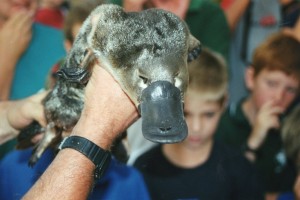In my head, I am thinking of an animal which lays eggs, has venom and dives in lakes & ponds to catch prey. Oh, it also has fur and mammary glands. If you are a little confused right now, do not worry, you are not alone. When European settlers in Australia first brought back pelts and drawings of this curious creature to England, scientists thought it was a hoax!
Rest assured that this animal is real. I am talking about the platypus, Ornithorhynchus anatinus. Native to the eastern and southern coasts of Australia, this semi-aquatic mammal builds its burrows deep into the banks of the bodies of freshwater in which it spends about 15% of its time. About half a metre long, the platypus has one of the highest fur densities of any animal with up to 90,000 hairs per cm2 (sea otters take the top spot with over 150,000/cm2!).
The three extant (i.e., still living) mammalian groups are the eutherians (e.g., humans), marsupials (e.g., kangaroos), and monotremes. Platypuses, along with echidnas are the only living members of the monotreme order. This group diverged from the last common mammalian ancestor about 166 million years ago, thus explaining the bizarre origins of this seemingly paradoxical egg-laying mammal.
As mentioned earlier, platypuses (or platypodes) forage for aquatic invertebrates on the bottom of lakes and streams. When it dives under water it closes its eyes, plugs its ears and does not use olfaction to detect its prey. You might think that it has run out of ways to find food, but that is definitely not the case here!
The skin on the bill of the platypus is highly specialized, containing at least two cutaneous receptors which aid in the location of prey. There are over 45,000 push-rod mechanoreceptors spread almost uniformly over the four surfaces of the bill. These receptors give the bill skin a sense of touch which is almost as sensitive as that on the tips of human fingers. More interestingly, platypus bill skin has over 38,000 sensory mucous gland electroreceptors. That’s right, electroreceptors!
These electroreceptors are so well-tuned that they can detect electrical signals from the muscle contractions of their invertebrate prey in the water. These electroreceptors are arranged in rostro-caudal stripes along the top and bottom bill surfaces (i.e., from tip to base of bill). It is thought that this striping pattern helps the platypus to pinpoint the exact location of its prey. By feeling the environment with the mechanoreceptors and detecting prey with the electroreceptors the platypus is very good at finding food without the use of sight, sound or taste.
When the platypus comes out of the water it is able to close these electroreceptor glands to prevent desiccation of mucous glands which are crucial to the function of these receptors. Platypuses are one of the few electroreceptive animals which have no specialized sensory cell to receive the incoming electrical stimulus. Instead, the electrical stimuli from prey are conducted through mucous and low resistance cells in an epidermal invagination to a bare nerve terminal.
As you can see, the electroreceptive ability of the platypus enables it to find food, therefore is crucial to the survival of this very bizarre animal.

Sources:
Grant, T.; Dawson, T. J. Physiol. Zool. 1978, 315-332.
Grant, T.; Temple-Smith, P. Philosophical Transactions of the Royal Society of London Series B-Biological Sciences 1998, 353, 1081-1091.
Klamt, M.; Thompson, R.; Davis, J. Global Change Biol. 2011, 17, 3011-3018.
Manger, P. R.; Pettigrew, J. D. Philosophical Transactions: Biological Sciences 1995, 359-381.
Manger, P.; Pettigrew, J. Brain Behavior and Evolution 1996, 48, 27-54.
Warren, W. C., et al Nature 2008, 453, 175-U1.
Platypus Parts. YouTube video. Accessed 12 February 2012.



















